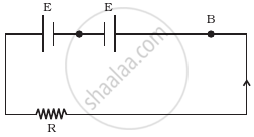Advertisements
Advertisements
प्रश्न
The graph between V and I for a conductor is a straight line passing through the origin.
What should remain constant in a statement of this law?
उत्तर
Ohm's law is true only if the temperature of the conductor is constant.
APPEARS IN
संबंधित प्रश्न
Find the resistance of a conductor if 0.24 A current is passing through it and a potential difference of 24 V is applied across it.
Will current flow more easily through a thick wire or a thin wire of the same material, when connected to the same source? Why?
A low voltage supply from which one needs high currents must have very low internal resistance. Why?
The graph between V and I for a conductor is a straight line passing through the origin.
Which law is illustrated by such a graph?
In a conductor 6.25 × `10^16` electrons flow from its end A to B in 2 s. Find the current flowing through the conductor (e = 1.6 × `10^-19` C)
What are non-ohmic conductors? Give one exmaple. Draw a current-voltage graph for a non-ohmic conductor.
SI unit of resistance is:
Explain the equivalent resistance of a series resistor network.
Consider a current carrying wire (current I) in the shape of a circle. Note that as the current progresses along the wire, the direction of j (current density) changes in an exact manner, while the current I remain unaffected. The agent that is essentially responsible for is ______.
Two cells of same emf E but internal resistance r1 and r2 are connected in series to an external resistor R (Figure). What should be the value of R so that the potential difference across the terminals of the first cell becomes zero.
